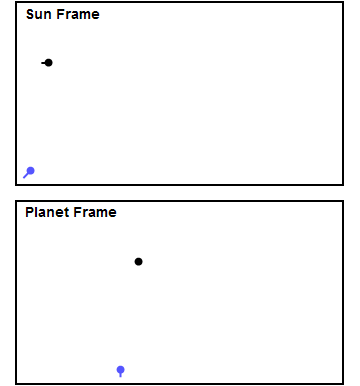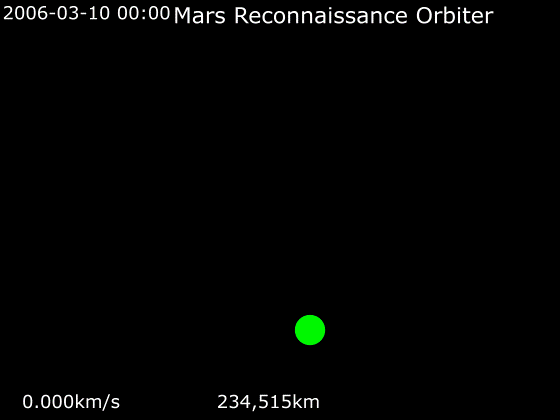|
Aerogravity Assist
An aerogravity assist, or AGA, is a theoretical spacecraft maneuver designed to change velocity when arriving at a body with an atmosphere. A pure gravity assist uses only the gravity of a body to change the direction of the spacecraft trajectory. The change in direction is limited by the mass of the body, and how closely it can be approached. An aerogravity assist uses a closer approach to the planet, dipping into the atmosphere, so the spacecraft can also use aerodynamic lift with upside-down wings to augment gravity and further curve the trajectory. This enables the spacecraft to deflect through a larger angle, resulting in a higher delta-v (change in velocity). This in turn allows a shorter travel time, a larger payload fraction of the spacecraft, or a smaller spacecraft for a given payload. The related techniques of aerocapture Aerocapture is an orbital transfer maneuver in which a spacecraft uses aerodynamic drag force from a single pass through a planetary atmospher ... [...More Info...] [...Related Items...] OR: [Wikipedia] [Google] [Baidu] |
Atmosphere
An atmosphere () is a layer of gas or layers of gases that envelop a planet, and is held in place by the gravity of the planetary body. A planet retains an atmosphere when the gravity is great and the temperature of the atmosphere is low. A stellar atmosphere is the outer region of a star, which includes the layers above the opaque photosphere; stars of low temperature might have outer atmospheres containing compound molecules. The atmosphere of Earth is composed of nitrogen (78%), oxygen (21%), argon (0.9%), carbon dioxide (0.04%) and trace gases. Most organisms use oxygen for respiration; lightning and bacteria perform nitrogen fixation to produce ammonia that is used to make nucleotides and amino acids; plants, algae, and cyanobacteria use carbon dioxide for photosynthesis. The layered composition of the atmosphere minimises the harmful effects of sunlight, ultraviolet radiation, the solar wind, and cosmic rays to protect organisms from genetic damage. The current c ... [...More Info...] [...Related Items...] OR: [Wikipedia] [Google] [Baidu] |
Gravity Assist
In orbital mechanics and aerospace engineering, a gravitational slingshot, gravity assist maneuver, or swing-by is the use of the relative movement (e.g. orbit around the Sun) and gravity of a planet or other astronomical object to alter the path and speed of a spacecraft, typically to save propellant and reduce expense. Gravity assistance can be used to accelerate a spacecraft, that is, to increase or decrease its speed or redirect its path. The "assist" is provided by the motion of the gravitating body as it pulls on the spacecraft. Any gain or loss of kinetic energy and velocity by a passing spacecraft is correspondingly lost or gained by the gravitational body, in accordance with Newton's Third Law. The gravity assist maneuver was first used in 1959 when the Soviet probe Luna 3 photographed the far side of Earth's Moon and it was used by interplanetary probes from Mariner 10 onward, including the two Voyager probes' notable flybys of Jupiter and Saturn. Explanation A ... [...More Info...] [...Related Items...] OR: [Wikipedia] [Google] [Baidu] |
Lift (force)
A fluid flowing around an object exerts a force on it. Lift is the component of this force that is perpendicular to the oncoming flow direction. It contrasts with the drag force, which is the component of the force parallel to the flow direction. Lift conventionally acts in an upward direction in order to counter the force of gravity, but it can act in any direction at right angles to the flow. If the surrounding fluid is air, the force is called an aerodynamic force. In water or any other liquid, it is called a hydrodynamic force. Dynamic lift is distinguished from other kinds of lift in fluids. Aerostatic lift or buoyancy, in which an internal fluid is lighter than the surrounding fluid, does not require movement and is used by balloons, blimps, dirigibles, boats, and submarines. Planing lift, in which only the lower portion of the body is immersed in a liquid flow, is used by motorboats, surfboards, windsurfers, sailboats, and water-skis. Overview A fluid flowing arou ... [...More Info...] [...Related Items...] OR: [Wikipedia] [Google] [Baidu] |
Delta-v
Delta-''v'' (more known as " change in velocity"), symbolized as ∆''v'' and pronounced ''delta-vee'', as used in spacecraft flight dynamics, is a measure of the impulse per unit of spacecraft mass that is needed to perform a maneuver such as launching from or landing on a planet or moon, or an in-space orbital maneuver. It is a scalar that has the units of speed. As used in this context, it is not the same as the physical change in velocity of the vehicle. As a simple example, take a conventional rocket-propelled spacecraft which achieves thrust by burning fuel. The spacecraft's delta-''v'' is the change in velocity that spacecraft can achieve by burning its entire fuel load. Delta-''v'' is produced by reaction engines, such as rocket engines, and is proportional to the thrust per unit mass and the burn time. It is used to determine the mass of propellant required for the given maneuver through the Tsiolkovsky rocket equation. For multiple maneuvers, delta-''v'' sums ... [...More Info...] [...Related Items...] OR: [Wikipedia] [Google] [Baidu] |
Aerocapture
Aerocapture is an orbital transfer maneuver in which a spacecraft uses aerodynamic drag force from a single pass through a planetary atmosphere to decelerate and achieve orbit insertion. Aerocapture uses a planet's or moon's atmosphere to accomplish a quick, near-propellantless orbit insertion maneuver to place a spacecraft in its science orbit. The aerocapture maneuver starts as the spacecraft enters the atmosphere of the target body from an interplanetary approach trajectory. The aerodynamic drag generated as the vehicle descends into the atmosphere slows the spacecraft. After the spacecraft slows enough to be captured by the planet, it exits the atmosphere and executes a small propulsive burn at the first apoapsis to raise the periapsis outside the atmosphere. Additional small burns may be required to correct apoapsis and inclination targeting errors before the initial science orbit is established. Compared to conventional propulsive orbit insertion, this nearly fuel-free met ... [...More Info...] [...Related Items...] OR: [Wikipedia] [Google] [Baidu] |
Aerobraking
Aerobraking is a spaceflight maneuver that reduces the high point of an elliptical orbit ( apoapsis) by flying the vehicle through the atmosphere at the low point of the orbit ( periapsis). The resulting drag slows the spacecraft. Aerobraking is used when a spacecraft requires a low orbit after arriving at a body with an atmosphere, as it requires less fuel than using propulsion to slow down. Method When an interplanetary vehicle arrives at its destination, it must reduce its velocity to achieve orbit or to land. To reach a low, near-circular orbit around a body with substantial gravity (as is required for many scientific studies), the required velocity changes can be on the order of kilometers per second. Using propulsion, the rocket equation dictates that a large fraction of the spacecraft mass must consist of fuel. This reduces the science payload and/or requires a large and expensive rocket. Provided the target body has an atmosphere, aerobraking can be used to reduce fuel ... [...More Info...] [...Related Items...] OR: [Wikipedia] [Google] [Baidu] |
Atmospheric Entry
Atmospheric entry is the movement of an object from outer space into and through the gases of an atmosphere of a planet, dwarf planet, or natural satellite. There are two main types of atmospheric entry: ''uncontrolled entry'', such as the entry of astronomical objects, space debris, or bolides; and ''controlled entry'' (or ''reentry'') of a spacecraft capable of being navigated or following a predetermined course. Technologies and procedures allowing the controlled atmospheric ''entry, descent, and landing'' of spacecraft are collectively termed as ''EDL''. Objects entering an atmosphere experience atmospheric drag, which puts mechanical stress on the object, and aerodynamic heating—caused mostly by compression of the air in front of the object, but also by drag. These forces can cause loss of mass (ablation) or even complete disintegration of smaller objects, and objects with lower compressive strength can explode. Crewed space vehicles must be slowed to subsonic spee ... [...More Info...] [...Related Items...] OR: [Wikipedia] [Google] [Baidu] |
Planetary Flyby
A planetary flyby is the act of sending a space probe past a planet or a dwarf planet close enough to record scientific data. This is a subset of the overall concept of a flyby in spaceflight. The first flyby of another planet with a functioning spacecraft took place on December 14, 1962, when Mariner 2 zoomed by the planet Venus. Planetary flybys are commonly used as gravity assist maneuvers to "slingshot" a space probe toward its primary target without expending fuel, but in some cases (such as with New Horizons), flybys are the primary objectives of a mission in of themselves. A relatively recent example of a flyby spacecraft is ''New Horizons,'' which performed flyby maneuvers of Jupiter, Pluto and its moons in the 21st century. The flyby of Jupiter, used as a gravity assist, allowed the craft to reach Pluto at high velocity without the complications of slowing down, after which it proceeded further into the Kuiper Belt on an escape trajectory out of the Solar System. L ... [...More Info...] [...Related Items...] OR: [Wikipedia] [Google] [Baidu] |
Flyby (spaceflight)
A flyby () is a spaceflight operation in which a spacecraft passes in proximity to another body, usually a target of its space exploration mission and/or a source of a gravity assist to impel it towards another target. Spacecraft which are specifically designed for this purpose are known as flyby spacecraft, although the term has also been used in regard to asteroid flybys of Earth for example. Important parameters are the time and distance of closest approach. Spacecraft flyby Flyby maneuvers can be conducted with a planet, a natural satellite or a non-planetary object such as a small Solar System body. Planetary flybys have occurred with Mars or Earth for example: *List of Earth flybys *Mars flyby An example of a comet flyby is when International Cometary Explorer (formerly ISEE-3) passed about from the Comet nucleus, nucleus of 21P/Giacobini–Zinner, Comet Giacobini-Zinner in September 1985. Another application of the flyby is of Earth's Moon, usually called a lunar flyby ... [...More Info...] [...Related Items...] OR: [Wikipedia] [Google] [Baidu] |
Pergamon Press
Pergamon Press was an Oxford-based publishing house, founded by Paul Rosbaud and Robert Maxwell, that published scientific and medical books and journals. Originally called Butterworth-Springer, it is now an imprint of Elsevier. History The core company, Butterworth-Springer, started in 1948 to bring the "Springer know-how and techniques of aggressive publishing in science"Joe Haines (1988) ''Maxwell'', Houghton Mifflin, p. 137. to Britain. Paul Rosbaud was the man with the knowledge. When Maxwell acquired the company in 1951, Rosbaud held a one-quarter share. They changed the house name to Pergamon Press, using a logo that was a reproduction of a Greek coin from Pergamon. Maxwell and Rosbaud worked together growing the company until May 1956, when, according to Joe Haines, Rosbaud was sacked. When Pergamon Press started it had only six serials and two books. Initially the company headquarters was in Fitzroy Square in West End of London. In 1959, the company moved into Hea ... [...More Info...] [...Related Items...] OR: [Wikipedia] [Google] [Baidu] |






.png)